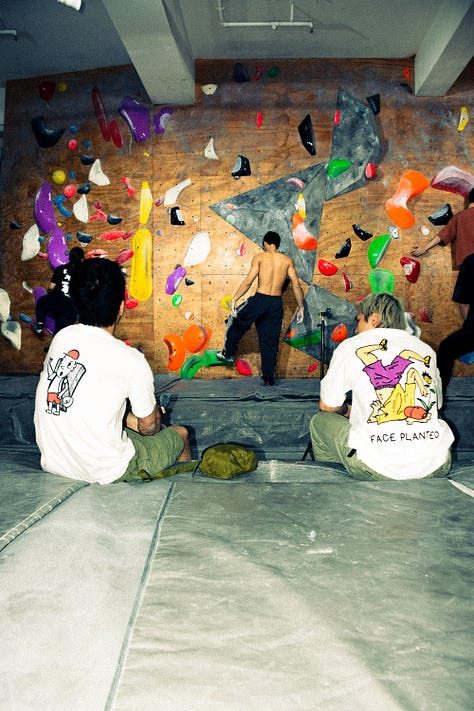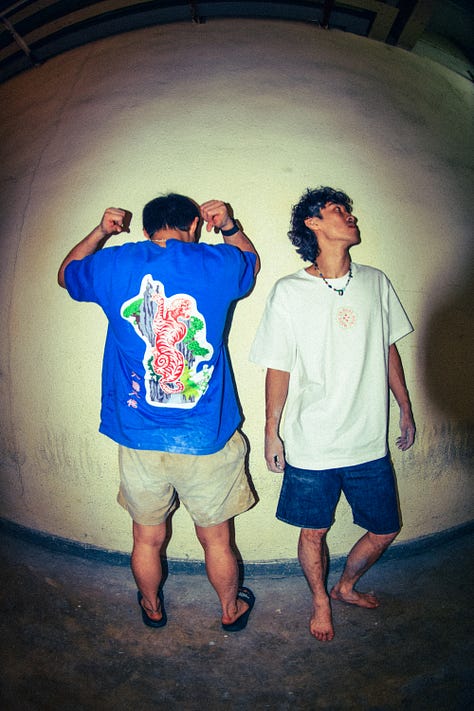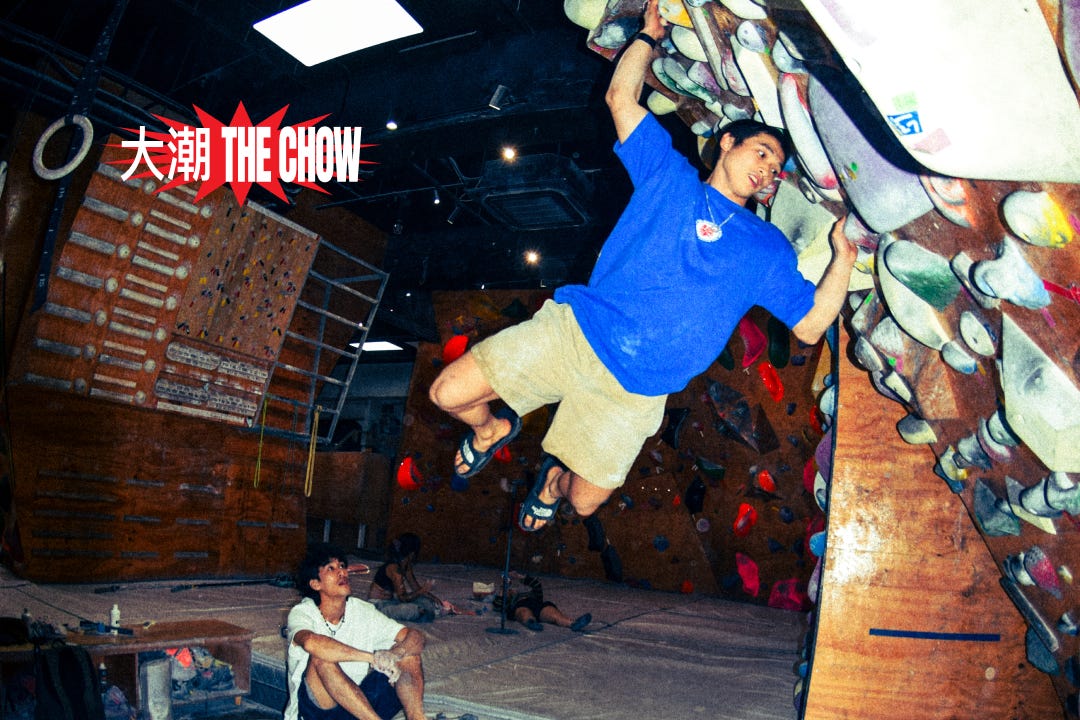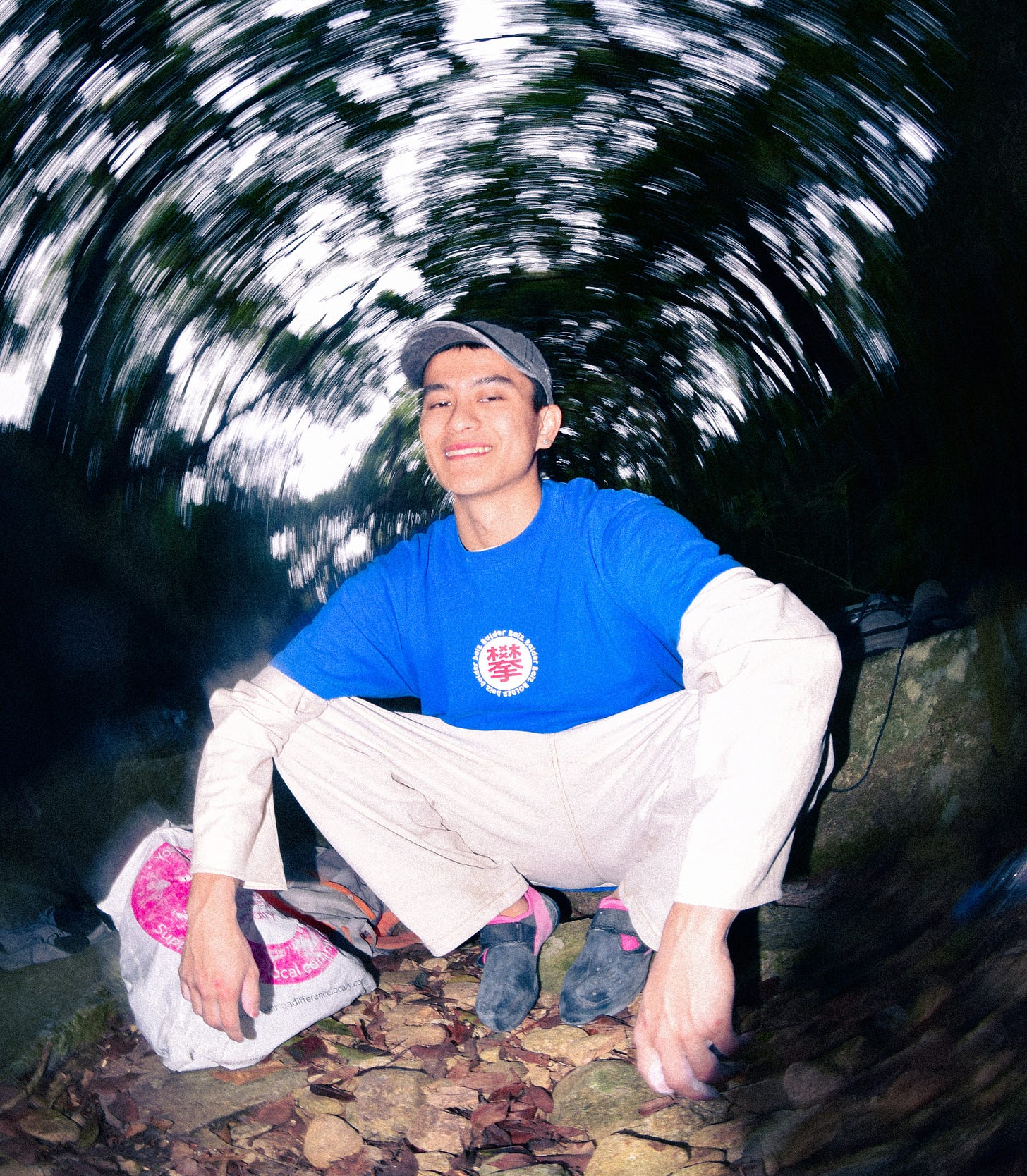The Boys Are Dressed to Climb
Bolder Boiz is creating a bouldering community—and building a streetwear brand on top of it.
Tucked underneath industrial warehouses is one of Hong Kong’s oldest bouldering gyms. On a Friday night, it’s packed with climbers unwinding after a long week. Bags are squeezed tightly along the floor, but life overflows even as the space gets cramped. Climbers eat home-cooked dinners in between sets, slurping pork and beancurd stew from metal thermoses. A man runs through the doors and screams the entire “Happy Birthday” song to his unassuming friend seated on the crash pads nearby.
Caius Man is sitting in between all of this, sketching designs on his iPad for Bolder Boiz, an indie streetwear brand he started three years ago.
Bolder Boiz is, as the name might imply, a collection of clothes for the boys who like to go bouldering. Caius’ brand sells a collection of loudly-designed, oversized t-shirts on its website. But while most Gen Z-founded streetwear brands launch a Shopify page, blast Instagram ads, pray that web traffic converts to sales, and then call it a day, Bolder Boiz operates differently: Rather than profit, it is focused on building community, and using baggy clothing as a way to unify it.
“In climbing, everyone’s friends with each other,” says Caius. “We hang out with basically anyone.” When he first started bouldering back in 2018, making friends through the sport was easy. Unlike other popular hobbyist sports like hydrox or weightlifting, bouldering is naturally more collaborative—you aren’t competing against anyone directly and “if you climb the same [path] with someone else, you do it together.”
A community centered around climbing became a natural aftereffect of joining the sport. “I invited one friend from school to come,” says Caius. “We ended up bringing more friends to climb together, creating our own little climbing crew.”
But while bringing people together was easy, having the crew stay together was the real challenge. The network was too informal, too easily splintered as people came and went. “In Hong Kong, everyone's so busy. It’s not easy to maintain one big collective,” says Caius. “We didn’t have a way of defining it.” Clothing, he decided, was an easy natural adhesive for a group of friends still divided.
“Bolder Boiz is me defining the community I climb with,” says Caius. It’s pioneering a new way to define bouldering crews in Hong Kong. It’s less of a “brand,” in the business-y sense, and more of an extended friend group wrapped in a set of baggy t-shirts. Or put differently, it’s a spread out but well-connected network of people that occasionally unite to do their favorite thing: Climb walls and wear oversized clothing while doing it.
Now might be a good time to mention that “boiz” in “Bolder Boiz” is about as gendered as the phrases “girl” or “the girls” on the internet, and by that I mean not at all: Most of the community’s 15 members are male, but a few women make up a fraction of the group too. The majority are in their late teens or early twenties, but Caius says the group often climbs with others who are as old as 40 or as young as 16.
Caius designs the t-shirts and manages the storefront, but the community takes an active part in the creative process, advising him on the t-shirt designs, and aligning them to reflect inside jokes or Hong Kong climer-bro catchphrases. Printed on one shirt is a man’s face on the floor, with a plant growing out of it (a literal “face-plant” for Caius’ friend who often falls on his face after a climb). Other designs are inscribed with Soviet-style typefaces (“There’s a lot of sharing, so it’s like communism,” Caius jokes). Plastered on another are the words, “The youth will always win”—a maxim often used by both bouldering enthusiasts and the streetwear legend Virgil Abloh.
In the last few years, businesses have become obsessed with “community”—according to Vox, it became a marketing buzzword as early as 2022. For direct-to-consumer businesses, the return on investment from people’s undying loyalty to your products is simple: Reap an easy profit whenever you release something new. “But the truth is, most brand communities aren’t communities at all,” writer
argues in thinking out loud. “They’re just customer lists with a coat of gloss.”In the age of brand activation pop-ups and companies making Discord servers for customers, Bolder Boiz might offer a simple lesson in actually creating a community around a product. The people supporting you come first, and (maybe) then you’ll accrue a profit along the way.
“I actually made more friends through clothes,” Caius says. “Friends of friends bought t-shirts from me to give to their friends. I didn't know them at the time, but they really f-cked with the Bolder Boiz style. And now we climb a lot together!”
But Bolder Boiz isn’t the first to create a climbing community and build a brand on top of it. One the brand’s main sources of inspiration is Armstrong, a bouldering crew in Seoul, which brings friends together in one gym and gives them branded t-shirts for a subscription fee.
It feels very reminiscent of the early days of Vans, Thrasher, and HUF—brands with histories in skating communities and later ruled streetwear in the 2010s. What allowed these brands to flourish was the customizability integral to the sport. There’s no set attire a skater needs to wear, and skateboard bottoms are full canvases for custom art.
Avenues for a DIY ethos are less obvious to climbing, when the equipment used is limited to shoes, chalk bags, bouldering brushes, and crash pads. But even within such a small selection of gear, customizability and expression are beginning to flourish. A few Bolder Boiz community members design their own chalk bags and paint their own shoes, and Caius is planning to create Bolder Boiz stickers to add to crash pads. Much like skateboarding, there are also less rules on what a climber needs to wear.
The market for custom bouldering attire is still in its infancy, but climbing is already a very personalized sport. “Everyone has their own unique style when they climb,” says Caius. “You can express yourself with the way you move” (his crew describes his style as “very weird” and “very powerful” on account of his “strong fingers”). When bouldering is done outdoors there’s an added layer of DIY ethos: When it’s just your extended friend group, some rocks, and a set of crashpads, untouched walls become a new puzzle to solve, a physical challenge, and a medium for self-expression. And ultimately, a space to carve community.



“Bolder Boiz [allows] me to show my friends Hong Kong’s climbing culture,” says Sasha, a community member who now lives in London. “It feels like Bolder Boiz helps me reacquaint myself with the Hong Kong community whenever I come back.”
There are dreams for the brand to expand eventually to other Asian countries. Some Bolder Boiz shirts are stocked in climbing gyms in Japan and Korea. But Caius promises it won’t come at the cost of the connections he’s made: “It’s really just about us having a good time at the end of the day,” Caius says.







